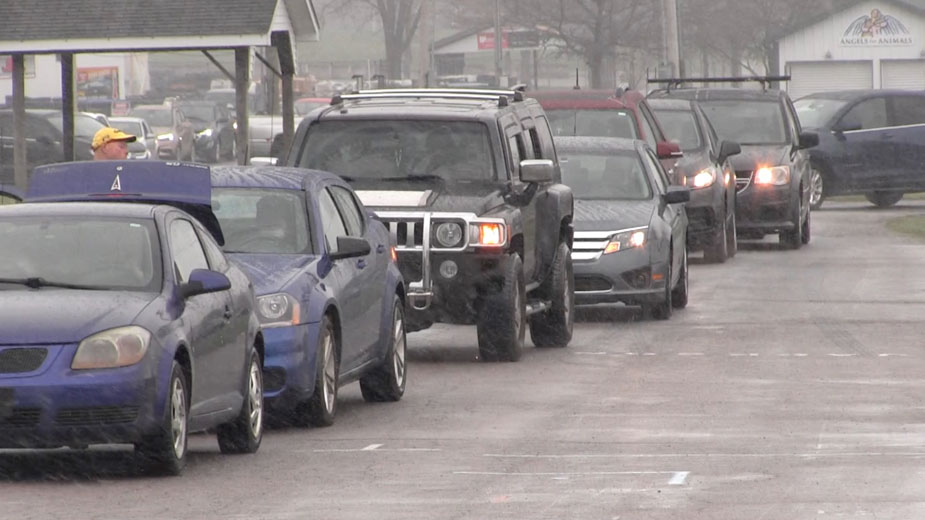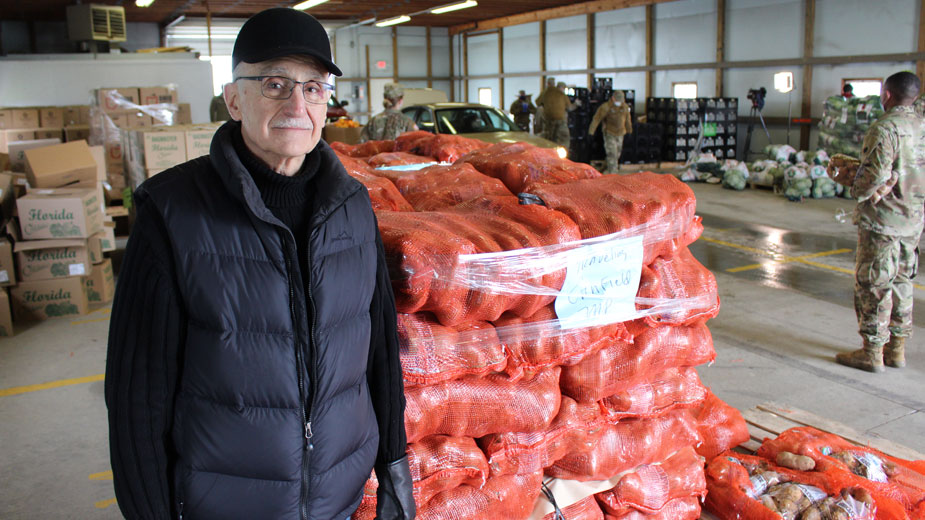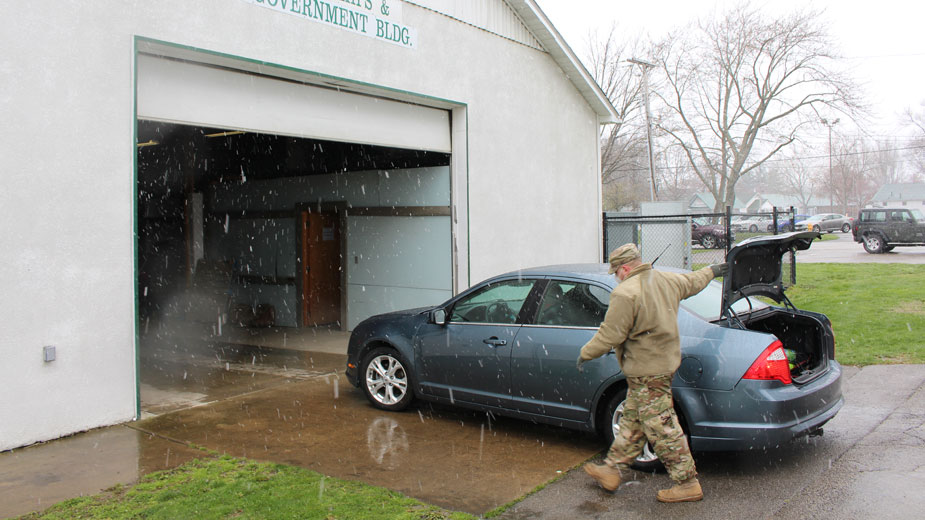Need Outweighs Supply at Traveling Food Pantry
By Jeremy Lydic
CANFIELD, Ohio — The 80,000 pounds of food that Second Harvest Food Bank had wasn’t enough to serve all of the vehicles that arrived Friday afternoon for the Traveling Food Pantry at the Canfield Fairgrounds.
The cars started lining up well before 2 p.m. start time, said Mike Iberis, executive director of the Second Harvest Food Bank of the Mahoning Valley. The food bank had brought enough food to serve about 625 vehicles during the no-contact distribution, but many more than that arrived, forcing the Ohio State Highway Patrol officers who volunteered to provide traffic control to turn some people away.
“More people showed up than we would have had food for,” Iberis said. “Which simply illustrates the fact that there’s great need in the Mahoning Valley.
“Would you stand in line for an hour or two for some groceries if you didn’t need it?” he added.
The line got so long that the highway patrol started letting people into the fairgrounds just before 1 p.m., Iberis said. Three food bank staffers and 10 members of the Ohio National Guard distributed the food, which included produce, milk and shelf-stable items.
Per zero-contact requirements, attendees could not leave their vehicles. They had to open their trunk from inside and keep their windows rolled up. The initiative is a direct result of the coronavirus pandemic, which has led to a 30% increase in traffic to food pantries in the Mahoning Valley, Iberis said.

Before the pandemic, the 150 food pantries and school-based pantries in the three-county region were seeing about 13,000 people weekly for a meal or bag of food, he said. “That number now, as of a couple weeks ago, is closer to 20,000 people each week,” he said.
“That is totally related to the layoffs. The people at our agencies are telling us there’s a lot of first timers coming,” Iberis noted, adding that 95% of the stories volunteers hear from individuals coming to the pantries are about being laid of from their job and not getting a paycheck in two weeks, or an unemployment check and are out of food.
“I did expect a large turnout because my counterparts told me that what we saw here in the Mahoning Valley is what they’re experiencing all in Ohio and across the nation,” Iberis said.
It’s also common for those picking up the food to do so for family members, friends and neighbors who don’t have reliable transportation, Iberis added.
“People without transportation are actually given a ride from someone in their church or someone who lives next door,” Iberis said. “Especially the elderly.”
For individuals who don’t have transportation or someone who can help, Second Harvest supplies food to organizations that serve residents who are home-bound, he said. The food bank provides a few thousand pounds weekly to Scope Senior Services, which delivers food to seniors’ homes, he said.
More Traveling Food Pantry dates are scheduled for 11 a.m. April 20 at Maplewood High School, 2414 Greenville Road NE, Cortland; and May 1 at Beaver Local School, 46090 Bell School Road, East Liverpool. Additional distributions are being planned for Mahoning, Trumbull and Columbiana counties.

Most of the food banks in the state are employing the zero-contact drive-thru method and are seeing similar results, said Joree Novotny, director of external affairs for the Ohio Association of Foodbanks. In Cleveland, drive-thru distributions were seeing lines of cars backed up for three or four miles, she said.
“That’s happening just about everywhere around the state,” Novotny said. “It’s difficult for us to anticipate how many people come week to week. We keep somehow being surprised because we think it couldn’t get any worse than this.”
In 2019, Ohio food banks and food pantries served just over 1.6 million individuals and provided some 15 million hot meals, Novotny said. Amid the coronavirus pandemic, “Food banks across the state are seeing anywhere from 50% more to doubling and sometimes tripling” those numbers, she said.
Last week, food banks in the state received a waiver from the U.S. Department of Agriculture allowing them to forego collecting household information in an effort to minimize person-to-person contact. Up until that point, Novotny said, a third of the people coming to hunger relief sites had never been there before.
Initially, food banks saw an influx of individuals laid off from hospitality and restaurant jobs, but now they’re seeing some from other sectors and industries, she said.

And with all 611 school districts in the state closed – some of which parents relied on for their kids’ breakfast and lunch – food banks are trying to fill the gap of the more than 170,000 K-12 students who received free or reduced lunches.
Regular visitors to food banks have also increased their frequency, she said, particularly those who were laid off from low-wage jobs, or senior citizens who are on fixed incomes.
“All of those people are turning to us more now because those people who needed help in the first place need more of it,” she said.
Last year, food banks in the state distributed about 4 million pounds of food weekly. Amid the pandemic, that has increased to just over 6.2 million pounds of food, she said.
“That will give you a picture of how quickly we’ve had to ramp up,” Novotny said. “As much as we can get it, we’re cycling through it more quickly.”
Additional federal funds through the Families First Coronavirus Response Act and the Cares Act will help supplement Ohio’s Emergency Food Assistance Program, which accounts for a third of food distributed in the state, Novotny said. However, the surplus goods and fresh foods – such as milk and dairy – that the USDA uses the funds to purchase won’t make their way to Ohio food bank warehouses until June.
“Meanwhile, we’re going through inventories like crazy,” Novotny said.

On April 13, an executive order signed by Gov. Mike DeWine provided $5 million in emergency funding from the Temporary Assistance to Needy Families block grant, or TANF, to assist the state’s food banks. The funds will be used to purchase products, a portion of which will go to Second Harvest Food Bank of the Mahoning Valley, she said.
“We have all our order sheets ready to go,” Novotny said. “We’re just waiting on the purchase order from the state to do so.”
To take some of the strain off of food banks, the Ohio Association of Foodbanks is supporting an effort to increase the maximum benefit through the Ohio Supplemental Nutrition Assistance Program, which would give recipients more money to spend at local grocery stores, she said.
Donations to foodbanks help as well and community donors in the Mahoning Valley “have stepped up to make sure there are funds available to get more food in,” Iberis said.
“We’re going to continue to do what we do. We will try to get as much food as we can and space it out in such a way as to serve as many people as possible.”
Copyright 2024 The Business Journal, Youngstown, Ohio.


